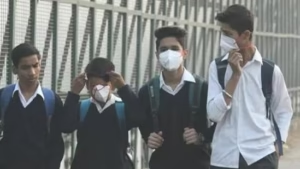Delhi Chokes Under Hazardous Smog Despite GRAP-4 Measures :- Delhi’s air quality plummeted to hazardous levels on Monday as a thick layer of toxic smog enveloped the city. Several areas recorded alarmingly high Air Quality Index (AQI) levels, with readings soaring past 1,500 in some regions. This dangerous escalation comes despite the implementation of Stage 4 of the Graded Response Action Plan (GRAP), aimed at curbing pollution.
The situation prompted authorities to move classes for students up to grade 9 online, while grades 10 and 12 continued with in-person attendance. By Monday evening, AQI readings at multiple monitoring stations crossed the “severe plus” threshold, hitting the maximum limit of 500 at locations like Anand Vihar, Vivek Vihar, and Chandni Chowk. According to the Central Pollution Control Board (CPCB), this severe air quality poses a grave risk to public health.

Delhi Chokes Under Hazardous Smog Despite GRAP-4 Measures. Scenes across the city captured the gravity of the situation. Commuters struggled through dense smog on NH 24 near Akshardham Temple, while monks and police officers donned masks for protection. Public spaces, including playgrounds, appeared desolate as residents avoided outdoor activities due to health concerns like eye irritation, respiratory issues, and fatigue. The toxic air also disrupted workplace productivity, adding to the city’s woes.
Authorities have intensified efforts to mitigate pollution. Measures include restrictions on trucks and banning BS-III petrol and BS-IV diesel vehicles across Delhi-NCR. Public transportation is being promoted as a cleaner alternative. Additionally, dust suppression strategies, such as spraying water on roads, were observed near landmarks like India Gate.
Despite these interventions, the city’s AQI remained alarmingly high, with a staggering score of 1,743 reported at 12:30 pm on Monday. For perspective, AQI scores over 300 are deemed hazardous, while levels below 101 are considered safe.
The worsening air quality has renewed calls for stringent, long-term solutions to combat pollution. Residents hope that stronger enforcement of policies and collective action will alleviate the annual smog crisis that disrupts lives and jeopardizes health in the nation’s capital.


